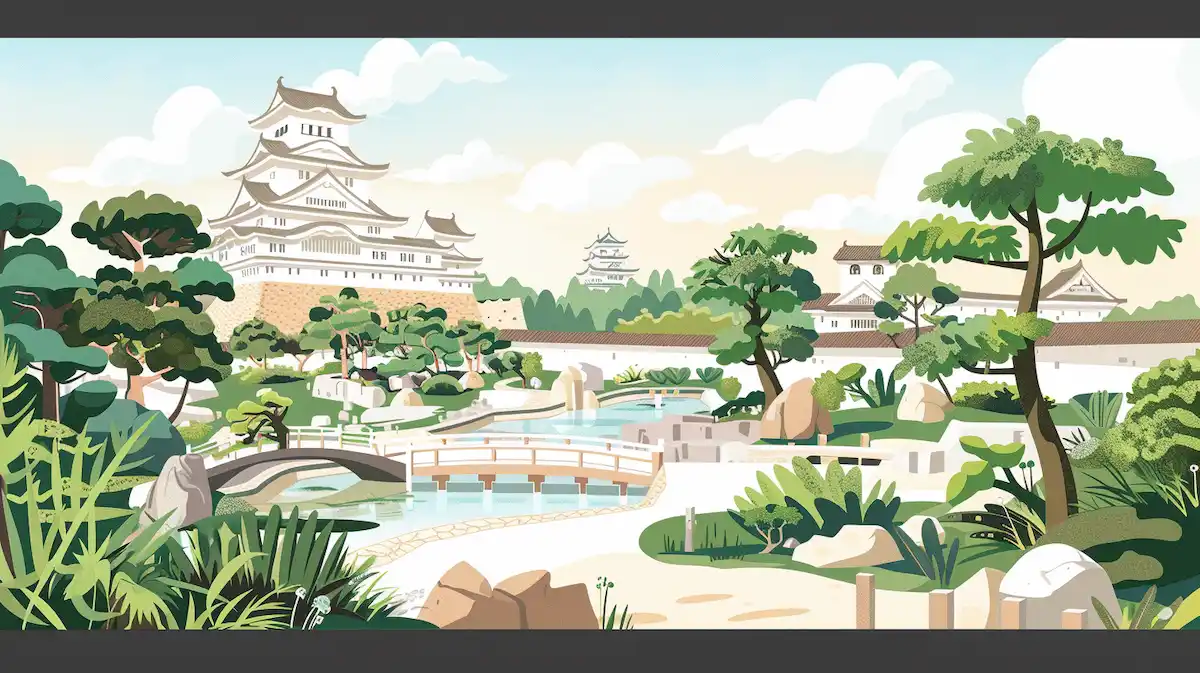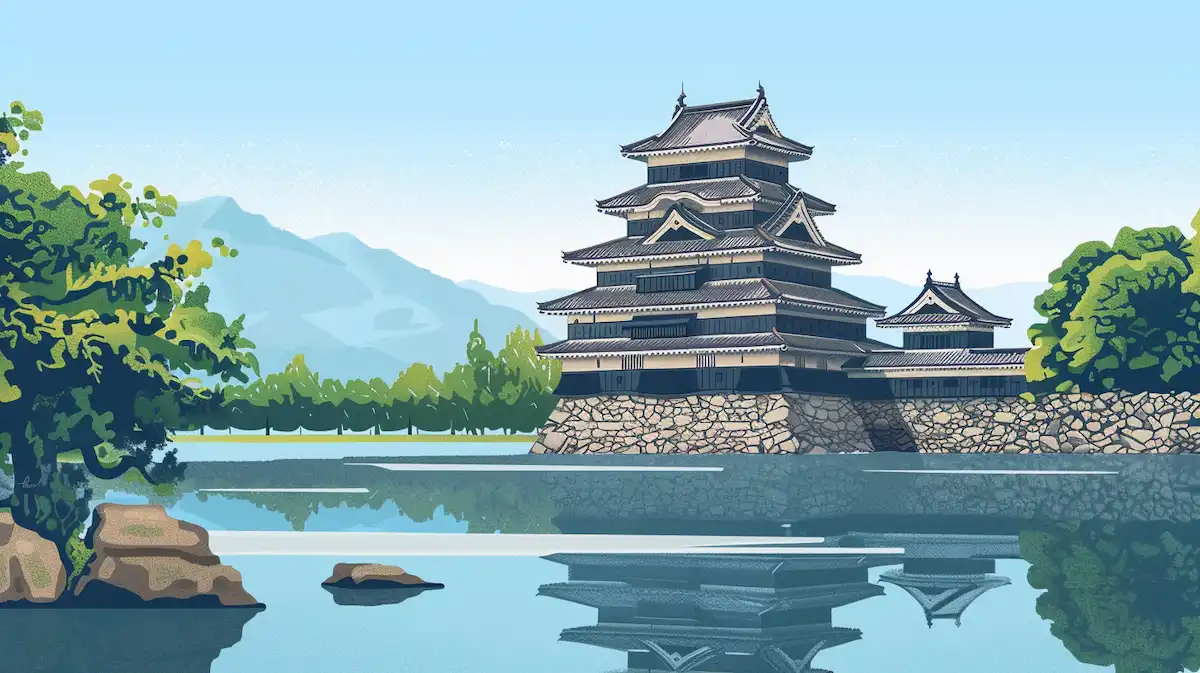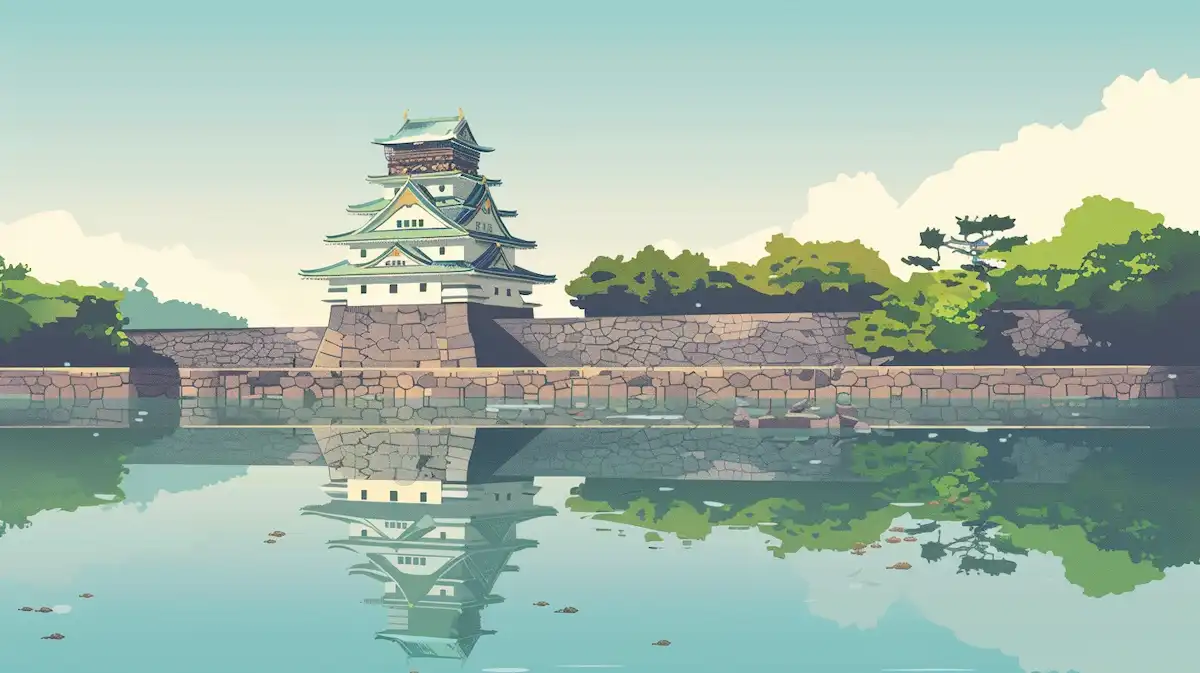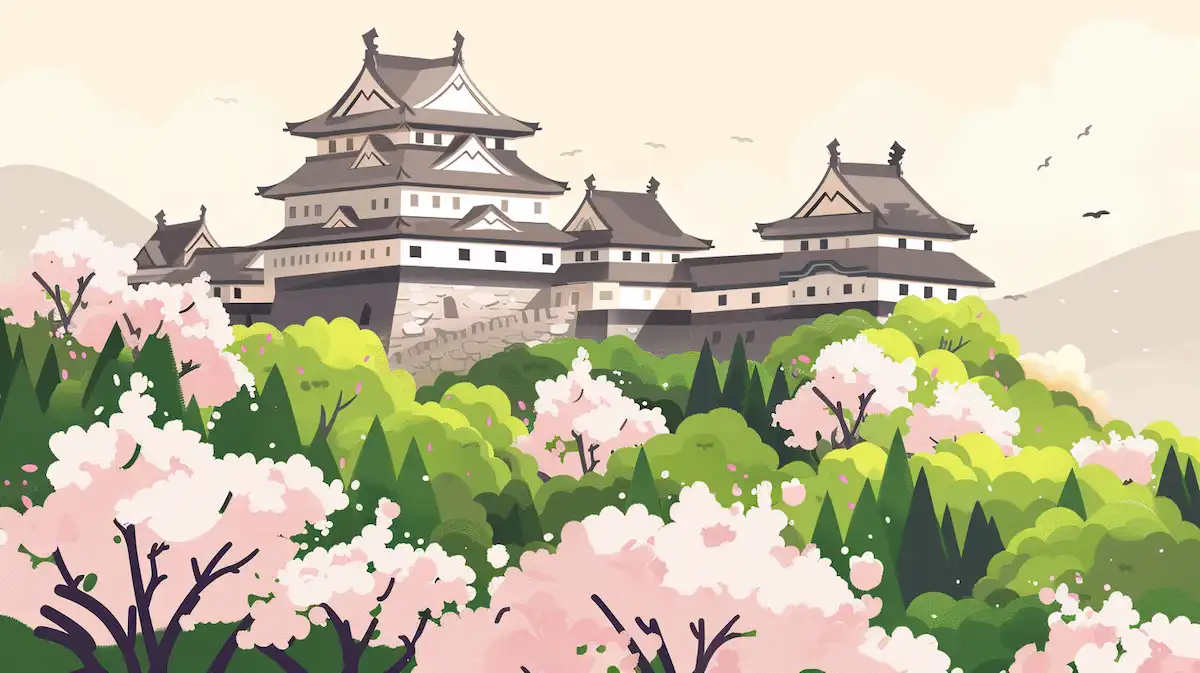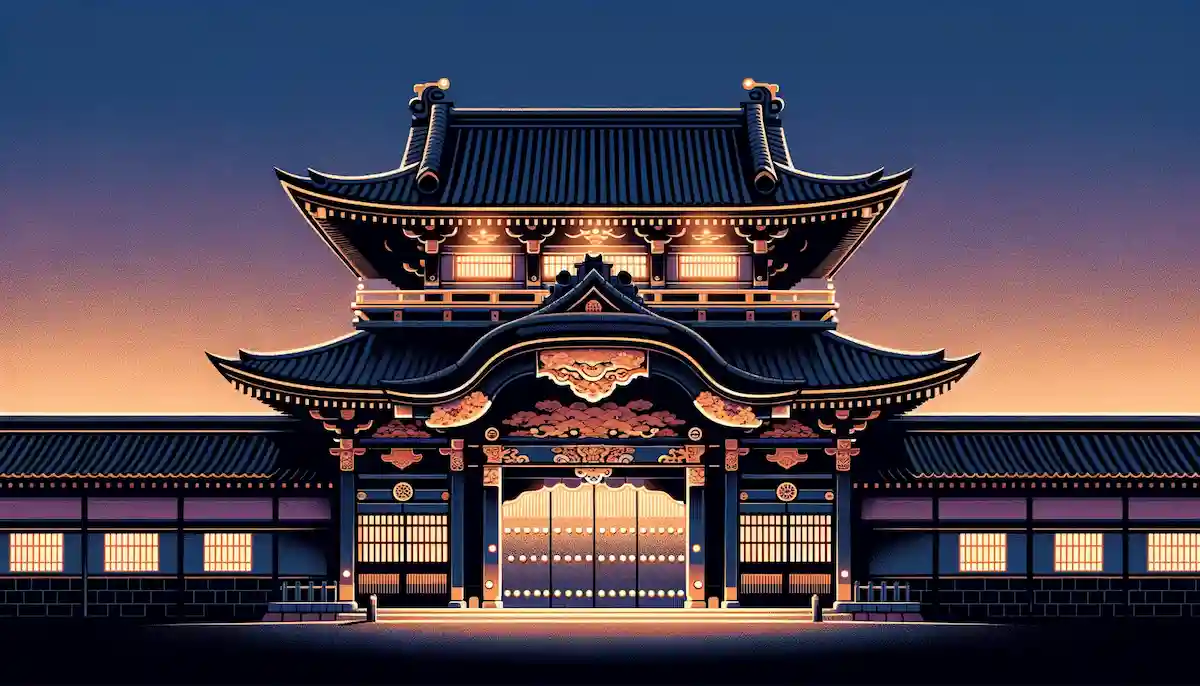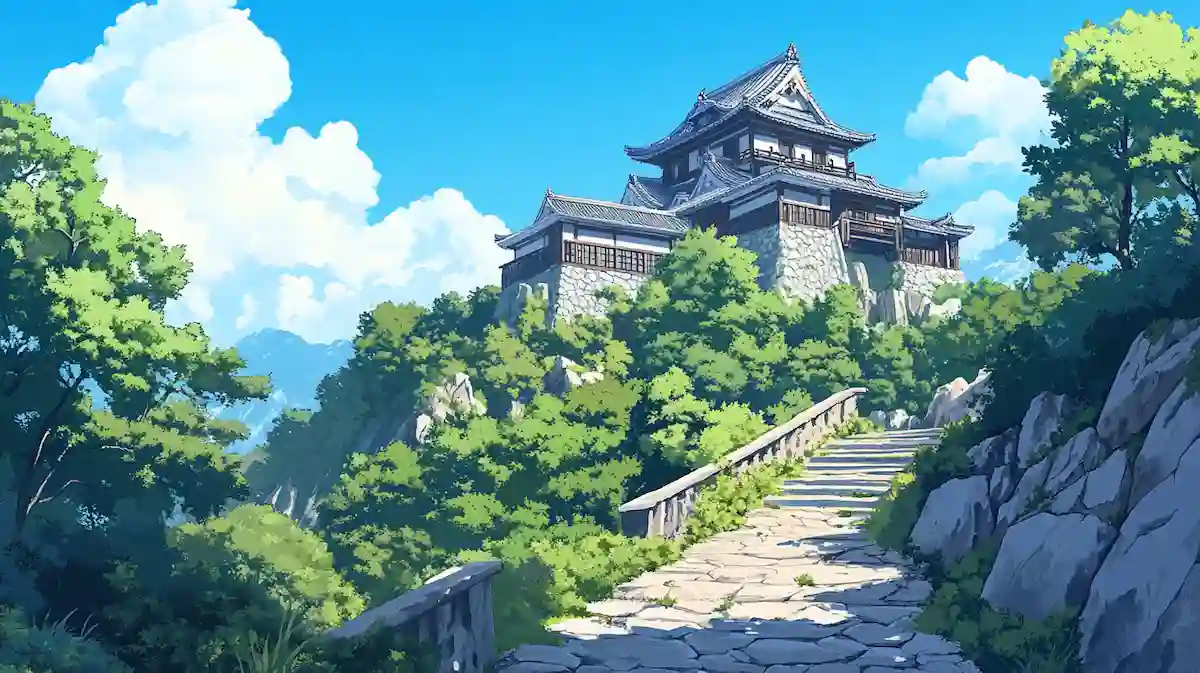日本の城を英語で説明・紹介するための基本情報と、英会話に役立つ表現をシンプルでわかりやすい英語で紹介します。
英会話ダイアローグ・概要・10の質問を通して、日本の城に関する英語表現を学びます。
英語
英会話ダイアローグを読む前に知っておくと良い前提知識と情報です。
- 日本の城の歴史的背景
- 平安時代や鎌倉時代 : 原型が生まれ山城が中心
- 戦国時代 : 各地の大名が領土防衛や権力誇示のために活発に築城、防御重視の城が発展
- 江戸時代: 政治・行政の中心としても機能、権威の象徴としての城へ変化
- 城の構造や用語の基本
- 天守 : 城のシンボルとなる主塔で、見張り台や権威を示す役割
- 石垣、堀 : 敵の侵入を防ぐための防御設備、石垣は曲線を活かして登りにくく、地震の揺れを吸収しやすい
- 門、櫓 : 城郭内を区画し、多重防御を可能にする
- 国宝・世界遺産の位置づけ
- 国宝天守 : 姫路城や松本城など、「江戸時代以前からの姿を保つ」貴重な建築物が指定されている
- 世界遺産 : 姫路城、二条城(古都京都の文化財の一部)、首里城(琉球王国のグスク及び関連遺産群の一部)などが登録されている
- 代表的な城とその特徴
- 姫路城 : 白鷺城の愛称で知られる優美さと防御構造を兼ね備えた国宝・世界遺産
- 松本城 : 黒い外観から“烏城”と呼ばれ、国宝天守を持つ
- 二条城 : 将軍の居所として建てられた、華やかな内装を持つ世界遺産
2人が日本の城について語しています。
城の歴史的な役割や特徴、姫路城や松本城など代表的な城の特徴や見どころなどを話題にしています。
会話 / dialogue

Hey Key, I’ve been living in Japan for a while now, but I still don’t know much about Japanese castles. Could you tell me why they’re so special?

Sure, Mack. Japanese castles have a long history, going back to around the Heian period. They really expanded during the Sengoku era, when warlords used them for defense and power.

That’s fascinating. I noticed that some castles look more like huge fortresses with high walls and deep moats. Is that a typical style?

Yes, definitely. The high stone walls and deep moats were crucial for stopping enemies. Plus, they often built the castles on hills or mountains for a natural advantage, or on flat land with multiple defenses.

I’ve heard about something called a “tenshu.” Is that just the main tower?

Correct. The tenshu is the main tower and often the most iconic part of the castle. It serves as a lookout point and a symbol of the lord’s authority.

So it’s not just about defense but also about showing off their power?

Exactly. Many castles were beautifully designed to impress, not only to defend. A good example is Himeji Castle, often called the “White Heron Castle” because of its elegant white walls.

Right, Himeji Castle is pretty famous, isn’t it?

It’s one of the most famous, and it’s both a National Treasure and a UNESCO World Heritage Site. Its original tower survived centuries of conflict and natural disasters.

That sounds amazing. Are there other National Treasure castles?

Yes. Along with Himeji, we have Matsumoto, Inuyama, Hikone, and Matsue. Each still has its pre-Edo main tower. For example, Matsumoto Castle has a striking black exterior, so people call it the “Crow Castle.”

I’ve seen pictures of Matsumoto Castle—really impressive. I’d love to visit. Maybe I can plan a short trip there.

Great idea! If you go, try to explore the inside. You’ll see steep wooden stairs and narrow hallways that show how the architects designed it for defense.

That must be such an experience. By the way, what about castles in Kyoto? I’ve heard Nijo Castle is famous.

Nijo Castle is also a World Heritage Site, but it’s different because it was built as a palace for the shogun rather than just a fortress. You can see beautiful interiors and sliding doors with gold-leaf paintings.

That contrast between a defensive structure and an artistic design is quite impressive. I guess it’s a reflection of Japanese culture.

Exactly. Another interesting example is Shuri Castle in Okinawa, which has a completely different style, influenced by the Ryukyu Kingdom.

Oh, I recall reading about it. Unfortunately, I heard it was damaged by a fire, right?

Yes, in 2019. But they’re working on restoring it. It’s still part of the “Gusuku Sites and Related Properties of the Kingdom of Ryukyu,” registered as World Heritage.

I appreciate all this info. Now I really want to see these castles in person. Any final tips?

Definitely check for castle events or night illuminations. And don’t forget to explore the castle towns for local foods and souvenirs. You’ll get a full historical and cultural experience!
概要 / Overview
「日本の城」について、理解を深めるための「英語での概要」です。
日本の城

History of Japanese Castles
Japanese castles have a long history. They started to appear in the Heian period (8th–12th century) and became more important during the Sengoku period (15th–16th century). During this time, warlords built castles to protect their land and show their power. In the Edo period (17th–19th century), castles became centers of government and culture. Many castles were destroyed in the Meiji period (late 19th century) and during World War II, but some were later restored.
Main Features of Japanese Castles
Japanese castles are different from Western castles. They are usually made of wood and have a tenshu (main tower). The main tower is tall and gives a good view of the surrounding area. Castles also have stone walls and moats to protect against enemies. Some castles are built on hills or mountains (mountain castles) to make them harder to attack, while others are built on flat land (flatland castles) with strong defensive structures.
Why Japanese Castles Are Amazing
Japanese castles are not just military buildings. They also have beautiful designs. Many castles use white walls and black roofs, creating a strong contrast. Some, like Himeji Castle, are so beautiful that they are compared to birds or animals. Castles also have hidden gates, narrow paths, and traps to confuse enemies. These features make Japanese castles unique and interesting.
Famous Japanese Castles
Some of the most famous Japanese castles are Himeji Castle, Matsumoto Castle, Kumamoto Castle, and Osaka Castle. Himeji Castle is a UNESCO World Heritage Site and a National Treasure. Matsumoto Castle is known for its black walls. Kumamoto Castle has strong stone walls, and Osaka Castle played an important role in Japanese history.
Visiting Japanese Castles
Many castles in Japan are now museums. Visitors can explore the towers, see old weapons and armor, and learn about history. Castles are also great places to enjoy the seasons. Cherry blossoms in spring and autumn leaves in fall make castles even more beautiful. Some castles have night illuminations and historical festivals.
10の質問 / 10 questions
「日本の城」について、理解を深めるための「英語での10の質問」です。
1: What is a Japanese castle?
A Japanese castle is a large structure built mainly for defense and as a symbol of power. It often includes a main tower (tenshu), stone walls, moats, and gates to protect against enemies.
2: When were Japanese castles built?
Japanese castles started appearing in the Heian period (8th–12th century) but became more common during the Sengoku period (15th–16th century) when warlords needed strong fortresses.
3: What are the main parts of a Japanese castle?
A Japanese castle usually has a tenshu (main tower), stone walls, moats, gates, and yagura (watchtowers). Some castles are built on mountains for extra protection.
4: What is special about Himeji Castle?
Himeji Castle is one of the most famous castles in Japan. It is a UNESCO World Heritage Site and a National Treasure, known for its white walls and elegant design.
5: Why do Japanese castles have stone walls and moats?
Stone walls make it difficult for enemies to climb, and moats prevent attackers from getting close. These features helped protect the castle from invasions.
6: What are the different types of Japanese castles?
There are three main types: mountain castles (yamajiro), which use natural landscapes for defense; hilltop castles (hirayamajiro), built on small hills; and flatland castles (hirajiro), built on plains with strong defensive structures.
7: What happened to many Japanese castles in modern times?
Many castles were destroyed during the Meiji period (late 19th century) and World War II. Some have been restored, while others remain as ruins or museums.
8: What are some famous Japanese castles besides Himeji Castle?
Other famous castles include Matsumoto Castle (known for its black walls), Kumamoto Castle (famous for its strong stone walls), and Osaka Castle (important in Japan’s history).
9: How do Japanese castles reflect Japanese culture?
Japanese castles combine military strength with beauty. Their design often includes elegant architecture, wooden structures, and harmony with nature.
10: What can visitors do at Japanese castles today?
Visitors can explore the towers, see historical exhibits, and enjoy seasonal beauty like cherry blossoms and autumn leaves. Some castles also have night illuminations and special events.
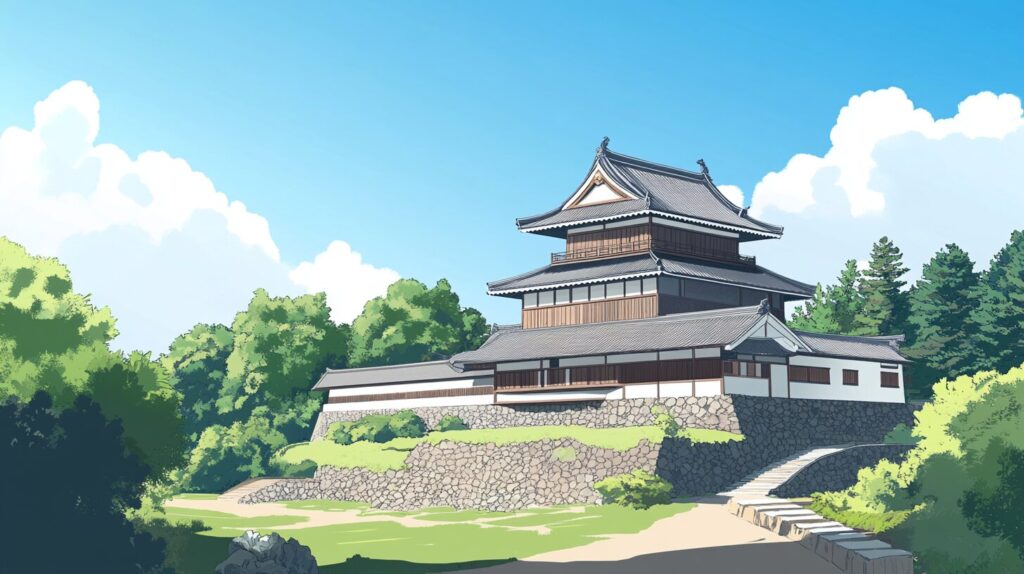
和訳付
会話 / dialogue

Hey Key, I’ve been living in Japan for a while now, but I still don’t know much about Japanese castles. Could you tell me why they’re so special?
やあキー。日本にはしばらく住んでいるけど、日本のお城についてはまだあまり知らないんだ。どうしてあんなに特別なのか、教えてくれない?

Sure, Mack. Japanese castles have a long history, going back to around the Heian period. They really expanded during the Sengoku era, when warlords used them for defense and power.
いいよ、マック。日本のお城は平安時代ごろから長い歴史があって、戦国時代に大名たちが領土防衛や権力誇示に使うようになって本格的に広がったんだ。

That’s fascinating. I noticed that some castles look more like huge fortresses with high walls and deep moats. Is that a typical style?
面白いね。高い石垣や深い堀があって、大きな要塞みたいなお城もあるよね。あれが一般的な形なの?

Yes, definitely. The high stone walls and deep moats were crucial for stopping enemies. Plus, they often built the castles on hills or mountains for a natural advantage, or on flat land with multiple defenses.
うん、そうだね。高い石垣や深い堀は敵の侵入を防ぐのに大事だったんだ。それに、自然の地形を活かすために丘や山の上に築くことも多かったし、平地だと複数の防御ラインを用意したりしてたんだ。

I’ve heard about something called a “tenshu.” Is that just the main tower?
“天守”っていうものを聞いたことがあるんだけど、それってお城のメインの塔のことなの?

Correct. The tenshu is the main tower and often the most iconic part of the castle. It serves as a lookout point and a symbol of the lord’s authority.
そうだよ。天守はお城の中心になる塔で、一番象徴的な部分なんだ。見張り台としても使われたし、大名の権威を示すシンボルにもなっていたんだ。

So it’s not just about defense but also about showing off their power?
じゃあ、防御だけじゃなくて、自分たちの力を見せつけるためでもあったってこと?

Exactly. Many castles were beautifully designed to impress, not only to defend. A good example is Himeji Castle, often called the “White Heron Castle” because of its elegant white walls.
その通り。お城は防御するだけじゃなく、人々を魅了するように美しく設計されてたんだ。いい例が姫路城で、白い壁が優雅だから“白鷺城”とも呼ばれているんだよ。

Right, Himeji Castle is pretty famous, isn’t it?
そうだね、姫路城はけっこう有名だよね?

It’s one of the most famous, and it’s both a National Treasure and a UNESCO World Heritage Site. Its original tower survived centuries of conflict and natural disasters.
日本でも特に有名なお城の一つだし、国宝でもありユネスコ世界遺産にも登録されているんだ。戦乱や自然災害を乗り越えて、今も当時のままの天守が残っているんだよ。

That sounds amazing. Are there other National Treasure castles?
それはすごいね。他にも国宝に指定されているお城ってあるの?

Yes. Along with Himeji, we have Matsumoto, Inuyama, Hikone, and Matsue. Each still has its pre-Edo main tower. For example, Matsumoto Castle has a striking black exterior, so people call it the “Crow Castle.”
うん。姫路城以外には、松本城、犬山城、彦根城、松江城が国宝として有名だね。どれも江戸時代より前の天守が残っているんだ。例えば松本城は黒い外観が目立つから、“烏城”って呼ばれてるよ。

I’ve seen pictures of Matsumoto Castle—really impressive. I’d love to visit. Maybe I can plan a short trip there.
松本城の写真を見たことあるけど、本当に迫力があるよね。行ってみたいな。ちょっと旅行の計画を立てようかな。

Great idea! If you go, try to explore the inside. You’ll see steep wooden stairs and narrow hallways that show how the architects designed it for defense.
それはいいね!もし行くなら中を見学してみるといいよ。急な木の階段とか細い通路とかがあって、防御を意識した構造がよくわかるから。

That must be such an experience. By the way, what about castles in Kyoto? I’ve heard Nijo Castle is famous.
すごい体験になりそうだね。ところで、京都のお城はどうなの?二条城が有名って聞いたことがあるけど。

Nijo Castle is also a World Heritage Site, but it’s different because it was built as a palace for the shogun rather than just a fortress. You can see beautiful interiors and sliding doors with gold-leaf paintings.
二条城も世界遺産だけど、防御施設というよりは将軍の住まいとして作られたから、ちょっと性格が違うんだ。豪華な内装や金箔が使われた襖絵なんかが見どころだよ。

That contrast between a defensive structure and an artistic design is quite impressive. I guess it’s a reflection of Japanese culture.
防御的な建物と芸術的なデザインの両面があるのはすごく印象的だね。日本文化の表れって感じがするよ。

Exactly. Another interesting example is Shuri Castle in Okinawa, which has a completely different style, influenced by the Ryukyu Kingdom.
まさにそうだね。もう一つ面白い例としては沖縄の首里城があって、琉球王国の影響を受けた全然違うスタイルなんだ。

Oh, I recall reading about it. Unfortunately, I heard it was damaged by a fire, right?
ああ、それは読んだことがあるよ。残念ながら火災で被害を受けたんだよね?

Yes, in 2019. But they’re working on restoring it. It’s still part of the “Gusuku Sites and Related Properties of the Kingdom of Ryukyu,” registered as World Heritage.
うん、2019年に火災があったんだ。でも今、再建に向けて工事が進んでいるよ。“琉球王国のグスク及び関連遺産群”として世界遺産に登録されたままだしね。

I appreciate all this info. Now I really want to see these castles in person. Any final tips?
いろいろ教えてくれてありがとう。実際にお城を見に行きたくなってきたよ。最後になにかアドバイスはある?

Definitely check for castle events or night illuminations. And don’t forget to explore the castle towns for local foods and souvenirs. You’ll get a full historical and cultural experience!
お城のイベントや夜のライトアップがあるかどうか調べてみるといいよ。それに城下町を散策して、ご当地の料理やおみやげを楽しむのもおすすめ。歴史も文化もまるごと味わえるからね!
概要 / Overview
日本の城

History of Japanese Castles
Japanese castles have a long history. They started to appear in the Heian period (8th–12th century) and became more important during the Sengoku period (15th–16th century). During this time, warlords built castles to protect their land and show their power. In the Edo period (17th–19th century), castles became centers of government and culture. Many castles were destroyed in the Meiji period (late 19th century) and during World War II, but some were later restored.
日本の城の歴史
日本の城には長い歴史があります。城が登場し始めたのは平安時代(8世紀~12世紀)で、戦国時代(15世紀~16世紀)にはさらに重要になりました。この時期、大名たちは自分の領地を守り、権力を示すために城を築きました。江戸時代(17世紀~19世紀)には、城は政治と文化の中心になりました。明治時代(19世紀後半)や第二次世界大戦中に多くの城が破壊されましたが、その後、一部は復元されました。
Main Features of Japanese Castles
Japanese castles are different from Western castles. They are usually made of wood and have a tenshu (main tower). The main tower is tall and gives a good view of the surrounding area. Castles also have stone walls and moats to protect against enemies. Some castles are built on hills or mountains (mountain castles) to make them harder to attack, while others are built on flat land (flatland castles) with strong defensive structures.
日本の城の主な特徴
日本の城は西洋の城とは異なります。通常、木造で作られ、天守(てんしゅ)と呼ばれるメインの塔を持っています。天守は高く作られ、周囲を見渡すことができます。城にはまた、石垣や堀があり、敵の侵入を防ぎます。山や丘の上に建てられる城(山城)は攻撃されにくいのが特徴で、一方、平地に建てられる城(平城)は防御設備を強化することで守りを固めていました。
Why Japanese Castles Are Amazing
Japanese castles are not just military buildings. They also have beautiful designs. Many castles use white walls and black roofs, creating a strong contrast. Some, like Himeji Castle, are so beautiful that they are compared to birds or animals. Castles also have hidden gates, narrow paths, and traps to confuse enemies. These features make Japanese castles unique and interesting.
日本の城のすごいところ
日本の城は単なる軍事施設ではありません。美しいデザインも持ち合わせています。多くの城は白壁と黒い屋根を使用し、見た目に強いコントラストを作り出しています。姫路城のように、その美しさから鳥や動物にたとえられる城もあります。また、敵を混乱させるために隠し門や狭い通路、罠が設置されていることもあります。これらの特徴が日本の城を独特で魅力的なものにしています。
Famous Japanese Castles
Some of the most famous Japanese castles are Himeji Castle, Matsumoto Castle, Kumamoto Castle, and Osaka Castle. Himeji Castle is a UNESCO World Heritage Site and a National Treasure. Matsumoto Castle is known for its black walls. Kumamoto Castle has strong stone walls, and Osaka Castle played an important role in Japanese history.
有名な日本の城
日本で特に有名な城には、姫路城、松本城、熊本城、大阪城があります。姫路城はユネスコ世界遺産に登録され、国宝にも指定されています。松本城は黒い壁で知られています。熊本城は頑丈な石垣が特徴で、大阪城は日本の歴史の中で重要な役割を果たしました。
Visiting Japanese Castles
Many castles in Japan are now museums. Visitors can explore the towers, see old weapons and armor, and learn about history. Castles are also great places to enjoy the seasons. Cherry blossoms in spring and autumn leaves in fall make castles even more beautiful. Some castles have night illuminations and historical festivals.
日本の城を訪れる楽しみ
現在、日本の多くの城は博物館として利用されています。訪れる人は天守を探索し、古い武器や鎧を見たり、歴史を学んだりできます。また、城は四季を楽しむのにも最適な場所です。春の桜や秋の紅葉が城をより美しく彩ります。さらに、一部の城では夜のライトアップや歴史的な祭りが開催されることもあります。
10の質問 / 10 questions
1: What is a Japanese castle?
日本の城とは何ですか?
A Japanese castle is a large structure built mainly for defense and as a symbol of power. It often includes a main tower (tenshu), stone walls, moats, and gates to protect against enemies.
日本の城は、主に防御と権力の象徴として建てられた大きな建築物です。通常、天守、石垣、堀、門などを備え、敵の侵入を防ぐ役割を持っています。
2: When were Japanese castles built?
日本の城はいつ建てられましたか?
Japanese castles started appearing in the Heian period (8th–12th century) but became more common during the Sengoku period (15th–16th century) when warlords needed strong fortresses.
日本の城は平安時代(8世紀~12世紀)に登場しましたが、戦国時代(15世紀~16世紀)に、大名たちが強固な要塞を必要とするようになり、本格的に普及しました。
3: What are the main parts of a Japanese castle?
日本の城の主な構造は何ですか?
A Japanese castle usually has a tenshu (main tower), stone walls, moats, gates, and yagura (watchtowers). Some castles are built on mountains for extra protection.
日本の城には通常、天守(主塔)、石垣、堀、門、櫓(見張り台)があります。防御を強化するために山の上に建てられる城もあります。
4: What is special about Himeji Castle?
姫路城の特別な点は何ですか?
Himeji Castle is one of the most famous castles in Japan. It is a UNESCO World Heritage Site and a National Treasure, known for its white walls and elegant design.
姫路城は日本で最も有名な城の一つです。ユネスコ世界遺産および国宝に指定されており、白い壁と優雅なデザインで知られています。
5: Why do Japanese castles have stone walls and moats?
日本の城にはなぜ石垣や堀があるのですか?
Stone walls make it difficult for enemies to climb, and moats prevent attackers from getting close. These features helped protect the castle from invasions.
石垣は敵が登りにくくするためのものであり、堀は敵の接近を防ぐ役割を果たします。これらの防御設備が城を外敵から守っていました。
6: What are the different types of Japanese castles?
日本の城にはどのような種類がありますか?
There are three main types: mountain castles (yamajiro), which use natural landscapes for defense; hilltop castles (hirayamajiro), built on small hills; and flatland castles (hirajiro), built on plains with strong defensive structures.
日本の城には大きく分けて3種類あります。自然の地形を利用する山城、小高い丘の上に建てられる平山城、平地に築かれ強固な防御設備を持つ平城です。
7: What happened to many Japanese castles in modern times?
近代になって、日本の城はどうなりましたか?
Many castles were destroyed during the Meiji period (late 19th century) and World War II. Some have been restored, while others remain as ruins or museums.
明治時代(19世紀後半)や第二次世界大戦中に多くの城が破壊されました。一部の城は復元され、他の城は遺跡や博物館として残っています。
8: What are some famous Japanese castles besides Himeji Castle?
姫路城以外の有名な日本の城は何ですか?
Other famous castles include Matsumoto Castle (known for its black walls), Kumamoto Castle (famous for its strong stone walls), and Osaka Castle (important in Japan’s history).
松本城(黒い壁で知られる)、熊本城(強固な石垣が有名)、大阪城(日本の歴史において重要な役割を果たした)などが、姫路城以外の有名な城です。
9: How do Japanese castles reflect Japanese culture?
日本の城は日本文化をどのように反映していますか?
Japanese castles combine military strength with beauty. Their design often includes elegant architecture, wooden structures, and harmony with nature.
日本の城は、軍事的な強さと美しさを兼ね備えています。優雅な建築、木造の構造、自然との調和が特徴です。
10: What can visitors do at Japanese castles today?
現在、日本の城では何ができますか?
Visitors can explore the towers, see historical exhibits, and enjoy seasonal beauty like cherry blossoms and autumn leaves. Some castles also have night illuminations and special events.
訪問者は天守を探索したり、歴史的展示を見たり、桜や紅葉など四季折々の美しさを楽しんだりできます。夜のライトアップや特別なイベントが開催される城もあります。
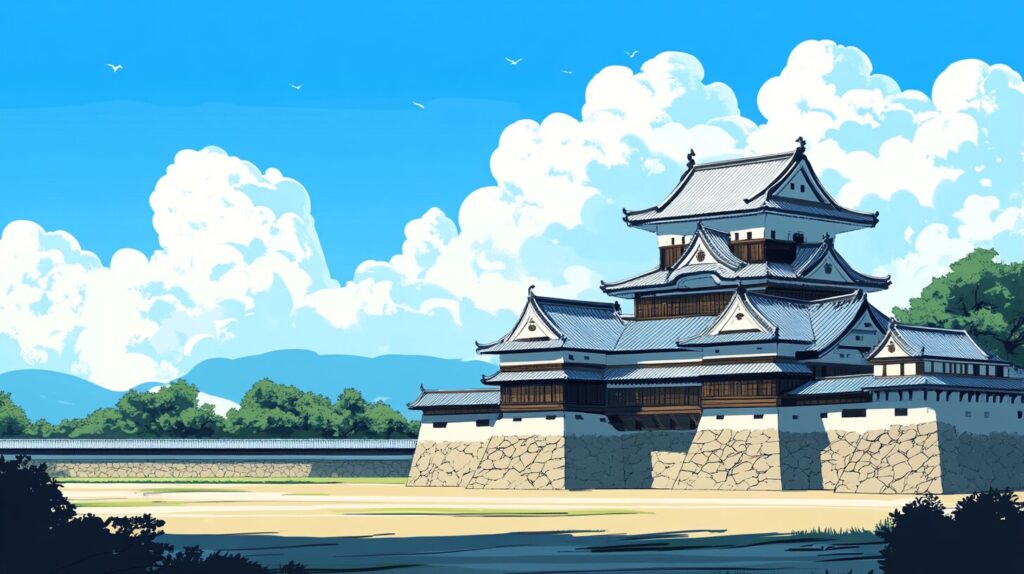
words & phrases
英会話ダイアローグと関連情報に出てきた単語・フレーズです(例文は各3つ)。

expand : 動詞
意味: 拡大する、広げる/ To become larger or to make something bigger
(城や領地が広がる様子を表す際に使用)
例文:
- The warlord wanted to expand his territory during the Sengoku period.
「戦国時代、その大名は自分の領地を拡大したいと考えていました。」 - The castle’s walls were rebuilt to expand its defensive range.
「城の壁は防御範囲を広げるために再建されました。」 - Cities often expand over time due to population growth.
「人口増加により都市は時間とともに拡大することが多いです。」
fortress : 名詞
意味: 要塞、堅固な城郭/ A large, strong building or group of buildings used to defend an area against attack
(石垣や堀による防御が強調される場合に使用)
例文:
- The castle was built like a fortress, with thick walls to keep out enemies.
「その城は要塞のように建てられ、敵を寄せつけない厚い壁がありました。」 - They turned the hilltop into a fortress during the war.
「戦争中、彼らは丘の上を要塞化しました。」 - From the fortress, soldiers could see any approaching armies.
「要塞からは、近づいてくる軍勢を見張ることができました。」
lookout : 名詞
意味: 見張り、監視所、見張り役/ A place or person that watches for danger or checks the surrounding area
(城の高い塔や櫓から外部を見渡す役割について説明する際に使用)
例文:
- A guard stood at the top of the tower on lookout for approaching enemies.
「衛兵が塔の上で敵が近づかないか見張りをしていました。」 - The castle’s design included a special lookout platform.
「その城の設計には特別な見張り用の台が含まれていました。」 - We need someone on lookout while we repair the gate.
「門を修理している間、誰かに見張りをしてもらう必要があります。」
impress : 動詞
意味: 感銘を与える、印象付ける/ To make someone feel admiration or respect
(城の美しさや規模の大きさが人々に深い印象を与える際に使用)
例文:
- The towering main tower of the castle never fails to impress visitors.
「そびえ立つ城の天守は、訪れた人々にいつも強い印象を与えます。」 - They wanted to impress the ruler with their architectural skills.
「彼らは自分たちの建築技術で支配者に感銘を与えたかったのです。」 - The beauty of the castle grounds really impressed me.
「その城の敷地の美しさは本当に私を感動させました。」
exterior : 名詞
意味: 外観、外部 / The outer surface or structure of something
(城の外側の壁や屋根の見た目を説明する際に使用)
例文:
- The castle’s exterior was painted white, giving it a bright appearance.
「城の外観は白く塗られていて、明るい印象を与えていました。」 - The exterior walls are made of sturdy stone blocks.
「外部の壁は頑丈な石のブロックでできています。」 - People often focus on the exterior, but the interior has fascinating details too.
「多くの人は外観に注目しがちですが、内部にも興味深い細部がたくさんあります。」
詳細情報 / Further Info
日本の城の起源と発展

Early Fortifications in Japan
Japanese castles began as simple fortifications in the Heian period (8th–12th century). These early forts were made of wood and earth and were built to protect villages from attacks. They were often placed on hills to make defense easier. During the Kamakura period (12th–14th century), the samurai class gained power, and castles became more important as military bases.
日本における初期の要塞
日本の城は、平安時代(8世紀~12世紀)に、シンプルな防御施設として始まりました。これらの初期の城は木と土で作られ、村を敵の攻撃から守るために建てられました。防御をしやすくするために、丘の上に築かれることが多かったのです。鎌倉時代(12世紀~14世紀)になると、武士階級が力を持ち、城は軍事拠点としてさらに重要になりました。
Castles in the Sengoku Period
The Sengoku period (15th–16th century) was a time of constant warfare between warlords. During this period, castles became larger, stronger, and more complex. Many were built with stone walls, moats, and multi-layered defenses to resist attacks. Some famous castles, like Azuchi Castle, were built by warlords such as Oda Nobunaga. Castles also became political centers, where warlords ruled their lands.
戦国時代の城
戦国時代(15世紀~16世紀)は、大名同士の戦争が絶えない時代でした。この時期、城はより大きく、強固で、複雑な構造になりました。多くの城には石垣、堀、多重の防御施設が作られ、攻撃に耐えられるようになりました。有名な城の一つである安土城は、織田信長によって築かれました。また、城は単なる防御施設ではなく、大名が領地を統治する政治の中心地としての役割も持つようになりました。
Edo Period and the Castle Restrictions
In the Edo period (17th–19th century), Japan became peaceful under the Tokugawa shogunate. Since wars stopped, castles were no longer needed for battle. However, they remained symbols of power and centers of government. The Tokugawa government passed a law called “One Castle per Province”, which limited the number of castles each domain could have. This helped maintain peace and control over the lords.
江戸時代と城の制限
江戸時代(17世紀~19世紀)には、徳川幕府の支配によって日本は平和になりました。戦争がなくなったため、城はもはや戦闘のためには必要なくなりました。しかし、城は依然として権力の象徴であり、政治の中心地でもありました。徳川幕府は「一国一城令」という法律を制定し、各藩が持てる城の数を制限しました。これにより、大名の勢力を抑え、平和を維持することができました。
Meiji Period and Castle Destruction
During the Meiji period (19th century), Japan modernized rapidly. Since castles were symbols of the old feudal system, many were destroyed or abandoned. Some were used as military bases, while others were turned into parks or government buildings. However, in the 20th century, efforts began to preserve and restore castles, recognizing their historical and cultural value.
明治時代と城の破壊
明治時代(19世紀)になると、日本は急速に近代化しました。城は封建制度の象徴とみなされ、多くが破壊されるか、放置されました。いくつかの城は軍事基地として使われ、また別の城は公園や役所に転用されました。しかし、20世紀に入ると、城の歴史的・文化的価値が再評価され、保存・復元の取り組みが始まりました。
Japanese Castles Today
Today, many castles have been rebuilt or restored. Some, like Himeji Castle, remain in their original form and are recognized as National Treasures and UNESCO World Heritage Sites. Others, like Osaka Castle, have been reconstructed using modern materials. Japanese castles are now popular tourist attractions, where visitors can learn about history and experience traditional culture.
現代の日本の城
現在、多くの城が再建または修復されています。姫路城のように当時の姿のまま残る城もあり、国宝やユネスコ世界遺産として認められています。一方、大阪城のように、近代的な材料を使って再建された城もあります。日本の城は現在、人気のある観光スポットとなっており、訪れる人々は歴史を学び、伝統文化を体験することができます。
天守と城の防御システム

The Purpose of the Tenshu
The tenshu (main tower) is the most important and symbolic part of a Japanese castle. It is usually the tallest structure in the castle and was used for surveillance, defense, and as a symbol of the lord’s power. From the top, guards could watch for enemies approaching the castle. The tenshu was also a safe place where the lord and important people could hide during attacks. Additionally, a grand and beautiful tenshu showed the strength and wealth of the castle owner.
天守の目的
天守は、日本の城の中で最も重要で象徴的な部分です。通常、城の中で最も高い建物であり、見張り、防御、大名の権威の象徴として使われました。天守の頂上からは、城の周囲を見渡し、敵の接近を監視することができました。また、天守は安全な避難場所として、大名や重要な人物が攻撃時に身を守る場所にもなりました。さらに、立派で美しい天守は、その城主の力や財力を示すものでもありました。
The Structure of the Tenshu
Tenshu towers were usually made of wood and stone, with multiple floors connected by steep stairs. The walls were built with plaster and wood, making them fire-resistant. Many tenshu also had hidden rooms and secret escape routes to protect the lord in case of an attack. The design of the tenshu varied between castles. Some had five or six floors, while others had only two or three. The unique shapes of tenshu made each castle special.
天守の構造
天守は通常、木と石で作られ、急な階段で結ばれた複数の階を持っていました。壁には漆喰と木が使われ、耐火性を高めていました。また、多くの天守には隠し部屋や秘密の脱出経路があり、攻撃されたときに大名を守るために利用されました。天守のデザインは城ごとに異なり、5階や6階のものもあれば、2階や3階のものもありました。それぞれの天守の形状が、城の個性を生み出していました。
Castle Walls and Moats
To protect the castle, strong stone walls were built around it. These walls were designed with a curved shape to make it harder for enemies to climb. In addition to stone walls, castles also had moats filled with water to stop enemies from reaching the castle. Some moats were dry, creating deep trenches that made it difficult to attack.
城壁と堀
城を守るために、強固な石垣が城の周囲に築かれました。これらの石垣は曲線を描くように作られ、敵が登るのを困難にしました。石垣に加えて、城には堀が設けられ、敵が城に近づくのを防ぎました。堀には水が入っているものもあれば、空堀(からぼり)と呼ばれる、水を使わない深い溝を作ることで、敵の侵入を困難にするものもありました。
Gates and Watchtowers
Castles had multiple gates to slow down attackers. Each gate was heavily guarded, and some gates were built with zigzag paths to confuse enemies. Castles also had yagura (watchtowers) along the walls. These towers were used by archers and gunmen to attack invaders from above. Some yagura were also used as storage places for food and weapons.
門と櫓(やぐら)
城には複数の門があり、敵の進入を遅らせる役割を果たしました。それぞれの門には厳重な警備があり、中には曲がりくねった道が作られ、敵を混乱させる設計になっているものもありました。また、城壁には櫓が設置されました。これらの櫓は、弓兵や鉄砲隊が上から敵を攻撃するために使われました。また、一部の櫓は、食料や武器の倉庫としての役割も果たしました。
Traps and Hidden Defenses
Japanese castles had many hidden traps to confuse and stop enemies. Some castles had false floors that would collapse when stepped on. Others had hidden doors leading to secret passages. Some paths inside the castle were intentionally made confusing, so that invaders would get lost while defenders knew the correct way.
罠と隠された防御設備
日本の城には、敵を混乱させ、侵入を防ぐための隠された罠が多くありました。例えば、一部の城には偽の床があり、敵が踏むと崩れる仕掛けになっていました。また、隠し扉が設けられ、秘密の通路につながることもありました。さらに、城の内部の道はわざと複雑に作られ、敵が迷うように設計されていました。一方で、防御側は正しい道を知っているため、有利に戦うことができました。
The Role of Castle Defense in History
The advanced defense systems of Japanese castles helped protect warlords during battles. Some castles, like Osaka Castle and Kumamoto Castle, were known for their strong defenses. Even today, these castles stand as a reminder of the strategic and architectural skills of ancient Japan.
歴史における城の防御の役割
日本の城の高度な防御システムは、戦国時代の大名たちを戦いの中で守る役割を果たしました。大阪城や熊本城のように、特に強固な防御を持つ城もありました。現在でも、これらの城は、日本の戦略的な知恵や建築技術の証として、多くの人々に親しまれています。
世界遺産登録の城

What is a UNESCO World Heritage Site?
UNESCO (United Nations Educational, Scientific and Cultural Organization) recognizes places with great historical, cultural, or natural value. A UNESCO World Heritage Site is a location that is important for all of humanity. In Japan, some castles have been registered as World Heritage Sites because of their unique history and architecture.
ユネスコ世界遺産とは?
ユネスコ(国際連合教育科学文化機関)は、歴史的・文化的・自然的に価値の高い場所を認定しています。ユネスコ世界遺産とは、人類全体にとって重要な場所のことを指します。日本では、特別な歴史や建築を持ついくつかの城が世界遺産として登録されています。
Himeji Castle: The White Heron Castle
Himeji Castle, registered as a World Heritage Site in 1993, is one of Japan’s most famous castles. It is also a National Treasure. The castle is called “White Heron Castle” because of its elegant white walls. It is known for its complex defense system, beautiful design, and well-preserved structure. Unlike many other castles, Himeji Castle has survived wars and natural disasters without major damage.
姫路城:「白鷺城」
姫路城は、1993年に世界遺産に登録された、日本で最も有名な城の一つです。また、国宝にも指定されています。白い美しい壁から「白鷺城(しらさぎじょう)」とも呼ばれます。姫路城は、複雑な防御システム、美しいデザイン、そしてよく保存された構造で知られています。他の多くの城とは異なり、姫路城は戦争や自然災害をほとんど無傷で生き延びました。
Nijo Castle: A Shogun’s Palace
Nijo Castle, in Kyoto, was registered as a World Heritage Site in 1994 as part of the “Historic Monuments of Ancient Kyoto.” Unlike other castles, Nijo Castle was built as a residence for the Tokugawa shogun rather than for defense. It is famous for its beautiful interior, gold-leaf paintings, and “nightingale floors” that make sounds when people walk on them.
二条城:将軍の宮殿
京都にある二条城は、1994年に「古都京都の文化財」の一部として世界遺産に登録されました。他の城とは異なり、二条城は徳川将軍の住居として建てられ、防御を目的としたものではありません。そのため、美しい内装、金箔の絵画、「うぐいす張り」の床(歩くと音が鳴る仕掛け)などで有名です。
Shuri Castle: The Ryukyu Kingdom’s Legacy
Shuri Castle, in Okinawa, was registered as a World Heritage Site in 2000 as part of the “Gusuku Sites and Related Properties of the Kingdom of Ryukyu.” It was the center of the Ryukyu Kingdom and has a unique design, influenced by both Japanese and Chinese architecture. Unfortunately, it was destroyed by fire in 2019, but efforts to restore it are ongoing.
首里城:琉球王国の遺産
沖縄にある首里城は、2000年に「琉球王国のグスク及び関連遺産群」の一部として世界遺産に登録されました。首里城は琉球王国の中心であり、日本と中国の建築の影響を受けた独特のデザインを持っています。しかし、2019年に火災で焼失しましたが、現在、復元作業が進められています。
The Importance of Preserving Castles
Japanese castles are an important part of the country’s history and culture. Being registered as World Heritage Sites helps to protect, restore, and promote these castles for future generations. Visiting these castles allows people to experience the beauty and history of Japan.
城を保存する重要性
日本の城は、日本の歴史と文化にとって重要なものです。世界遺産に登録されることで、これらの城を保護し、修復し、未来へ伝えることができます。これらの城を訪れることで、日本の美しさと歴史を直接体験することができます。
現存12天守と国宝5城

What Are the 12 Original Castles?
The 12 original castles in Japan are castles that still have their original main tower (tenshu) from before the Edo period. Many castles were destroyed during wars, natural disasters, or the Meiji period. However, these 12 castles have survived for hundreds of years and still maintain their historical structures. They are valuable because they show authentic Japanese castle architecture.
現存12天守とは?
日本の現存12天守とは、江戸時代以前に建てられた天守が現在も残っている城のことです。多くの城は戦争、自然災害、明治時代の政策によって破壊されました。しかし、この12の城は数百年の歴史を持ち、当時の姿をそのまま残しているため、非常に貴重です。これらの城は、日本の本来の城の建築様式を伝えています。
List of the 12 Original Castles
The 12 original castles include Himeji Castle, Matsumoto Castle, Hikone Castle, Inuyama Castle, Matsue Castle, Hirosaki Castle, Marugame Castle, Uwajima Castle, Kochi Castle, Bitchu Matsuyama Castle, Maruoka Castle, and Matsuyama Castle. These castles are located all over Japan and each has unique architectural features and history.
現存12天守のリスト
現存12天守には、姫路城、松本城、彦根城、犬山城、松江城、弘前城、丸亀城、宇和島城、高知城、備中松山城、丸岡城、松山城があります。これらの城は日本各地にあり、それぞれ独自の建築スタイルや歴史を持っています。
What Are the 5 National Treasure Castles?
Among the 12 original castles, five are designated as National Treasures. These castles have exceptional historical and cultural value. They are:
1.Himeji Castle – A UNESCO World Heritage Site, famous for its beautiful white walls.
2.Matsumoto Castle – Known for its unique black exterior.
3.Hikone Castle – Features an elegant main tower and important historical artifacts.
4.Inuyama Castle – One of the oldest wooden castle towers in Japan.
5.Matsue Castle – Recently recognized as a National Treasure for its well-preserved structure.
国宝5城とは?
現存12天守の中でも、特に価値の高い5つの城が国宝に指定されています。これらの城は歴史的・文化的に重要とされ、次の5つが選ばれています。
1.姫路城 – ユネスコ世界遺産にも登録され、美しい白壁で有名。
2.松本城 – 黒い外観が特徴的で「烏城」とも呼ばれる。
3.彦根城 – 優雅な天守と貴重な歴史的資料が残る。
4.犬山城 – 日本最古の木造天守の一つ。
5.松江城 – 最近国宝に指定された、保存状態の良い城。
Why Are These Castles Important?
These castles are important because they show real Japanese castle architecture. Many castles in Japan today are reconstructed, but these 12 castles still have their original wooden structures. This makes them valuable for studying history and experiencing authentic samurai-era buildings.
なぜこれらの城は重要なのか?
これらの城は、日本の本来の城の建築を今に伝えているため、とても貴重です。現在の日本の城の多くは再建されたものですが、この12の城は今でも木造の天守が残っているため、当時の建築や歴史を学ぶのに最適です。
Visiting the Original Castles
Many of these castles are now popular tourist sites. Visitors can explore the castle interiors, climb to the top of the tenshu, and see historical exhibits. Some castles, like Matsumoto Castle, also have samurai armor displays. Visiting these castles is a great way to experience Japan’s rich history.
現存天守の城を訪れる
これらの城の多くは人気の観光地になっています。訪れると、天守の内部を見学し、頂上からの景色を楽しんだり、歴史的展示を見たりすることができます。松本城などでは、侍の甲冑が展示されていることもあります。これらの城を訪れることで、日本の豊かな歴史を体験することができます。
日本の城を楽しむ観光ガイド

Best Seasons to Visit Japanese Castles
Japanese castles are beautiful in every season, but the best times to visit are spring and autumn. In spring, many castles are surrounded by cherry blossoms, creating a breathtaking view. Some famous cherry blossom spots include Himeji Castle and Matsumoto Castle. In autumn, the red and yellow leaves around castles, such as Osaka Castle and Hikone Castle, offer a stunning contrast against their traditional architecture.
日本の城を訪れるのに最適な季節
日本の城は四季折々の美しさがありますが、特におすすめなのは春と秋です。春には、多くの城が桜に囲まれ、幻想的な景色を楽しめます。桜の名所として有名なのは姫路城や松本城です。秋には、赤や黄色の紅葉が広がり、大阪城や彦根城などの伝統的な建築と見事なコントラストを生み出します。
Famous Castles to Visit
Some of the most popular castles for tourists include Himeji Castle, Matsumoto Castle, Osaka Castle, and Kumamoto Castle. Himeji Castle is a UNESCO World Heritage Site and one of Japan’s most beautiful castles. Matsumoto Castle is famous for its black exterior. Osaka Castle played an important role in history and has a large museum inside. Kumamoto Castle is known for its strong stone walls and impressive design.
訪れるべき有名な城
観光客に人気のある城には、姫路城、松本城、大阪城、熊本城などがあります。姫路城はユネスコ世界遺産で、日本で最も美しい城の一つです。松本城は黒い外観が特徴的です。大阪城は歴史的に重要な役割を果たし、内部には大きな博物館があります。熊本城は、強固な石垣と壮大な設計で知られています。
Experiences at Japanese Castles
Visiting a Japanese castle is more than just sightseeing. Many castles offer samurai armor experiences, where visitors can wear samurai helmets and clothing. Some castles also have guided tours, explaining the history and architecture. In castle towns, visitors can enjoy traditional food like matcha sweets in Matsue or Hida beef in Takayama.
日本の城でできる体験
日本の城を訪れることは、単なる観光以上の体験です。多くの城では、侍の甲冑を着る体験ができ、侍の兜や衣装を試すことができます。また、一部の城では、ガイドツアーがあり、歴史や建築について詳しく学ぶことができます。城下町では、松江の抹茶スイーツや高山の飛騨牛などの伝統的な料理を楽しむこともできます。
Castle Events and Night Illuminations
Many castles host special events and night illuminations. Some castles, like Osaka Castle and Nagoya Castle, have light-up events in the evening, creating a magical atmosphere. Seasonal events, such as samurai performances and historical festivals, allow visitors to experience Japanese history in an exciting way.
城のイベントと夜のライトアップ
多くの城では、特別なイベントや夜のライトアップが行われます。大阪城や名古屋城では、夜のライトアップイベントが開催され、幻想的な雰囲気を楽しめます。また、侍のパフォーマンスや歴史祭りなどの季節イベントでは、日本の歴史をより身近に体験できます。
Tips for Visiting Japanese Castles
Before visiting, check the opening hours and entrance fees. Some castles are partially closed for renovations, so it’s best to check online. Wear comfortable shoes, as many castles have steep stairs and long walking paths. Finally, enjoy exploring the castle town, where you can find local souvenirs and traditional foods.
日本の城を訪れる際のポイント
訪れる前に、開館時間や入場料を確認しましょう。一部の城は修復工事中のこともあるので、事前にオンラインで情報をチェックするのがおすすめです。また、城内には急な階段や長い歩道があるため、歩きやすい靴を履いていきましょう。最後に、城下町を散策し、地元のお土産や伝統料理を楽しむのもおすすめです。
関連記事(姫路城・松本城・大阪城・松江城・松山城・二条城・竹田城跡)
